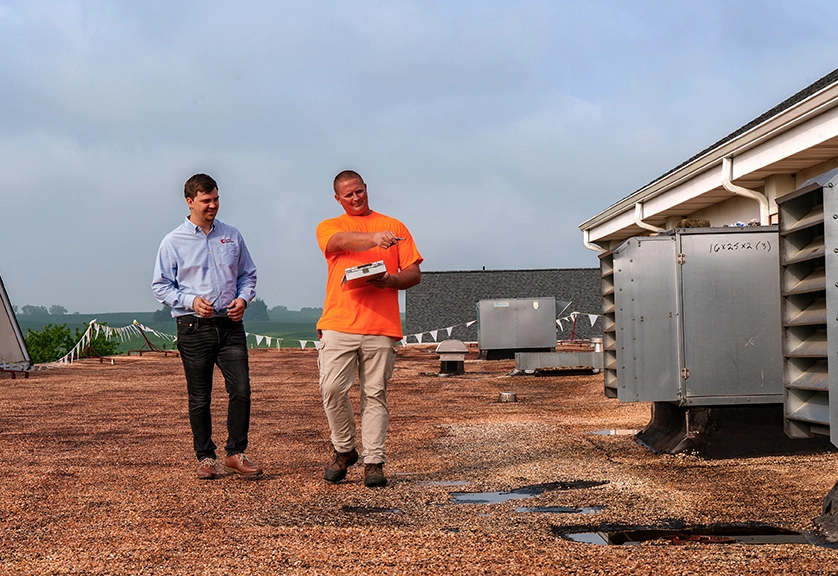Commercial Roof Documentation Can Save You Money
There are many aspects to consider when it comes to keeping a large commercial facility up and running. Facility managers who aren’t organized and don’t have the proper systems in place could be wasting thousands of dollars each year. One of the most critical sections of a commercial facility that often gets overlooked is the roofing system.

A roof plays a critical role in protecting a building and everything in it—employees, customers, equipment, and inventory—from outdoor contaminants and adverse weather conditions. Understanding the type of roof you have, how it should function, and properly documenting issues concerning it and its components play a crucial role in commercial roof maintenance and cost savings.
So how should a facility manager properly document commercial roof maintenance? What items should be considered? The list that follows will help you get started.
Maintain Good Records
Facility managers should get into the habit of maintaining detailed records concerning everything that affects their commercial roofing system. Installation, maintenance, inspections, repairs, and any replacements should all be documented. Historical records will help keep track of the roof’s condition over time, enabling the maintenance team to identify patterns, trends, potential issues, and future projects that may be necessary.
Documentation also serves as a communication tool among the different stakeholders at a company. This includes facility managers, maintenance teams, contractors, and building owners. Clear and detailed records will facilitate effective communication and help coworkers make informed decisions about maintenance priorities, timelines, and resource allocation.
Asset Management
Because a commercial roof is such a significant asset for any business, proper documentation is essential in managing this critical piece of infrastructure effectively. The first asset that should be noted is the commercial building roof type: is it single-ply, spray foam, metal, or shingle? Learning more about the type of roof you have and recording its installation date, warranty information, and any modifications or repairs that have been performed is important. This information will aid facility managers in making informed decisions about necessary repairs, replacements, or upgrades that could impact budget planning. By keeping track of repairs and maintenance costs over time, businesses can also better estimate future expenses, allocate funds appropriately, and prioritize maintenance tasks. Is there copy for a second asset?
Compliance and Regulations
Commercial properties are often subject to building codes and regulations related to roof maintenance. Proper documentation ensures that any maintenance activities performed comply with warranties, as well as local and industry regulations. This proactive cost-savings measure may also prevent potential legal issues and/or fees and protect the business’ liability, since these actions demonstrate the company is taking measures to properly care for its roof according to applicable building codes and laws.
Warranty Management
Many commercial roofs come with warranties from the roofing material manufacturer or the company that performed the installation. To ensure the warranty remains valid, facility managers should take note of the length of the warranty and any recommended maintenance activities. Proper documentation of the installation and any maintenance activities performed during the life of the roof will be essential to ensuring warranty compliance. If a warranty claim does need to be filed, this information will provide evidence of adherence to the warranty guidelines.
Commercial Roof Assessments
With time, everything ages and even sturdy commercial roofing materials can deteriorate, which is why it’s important to assess the overall structural integrity of a roof by conducting regular commercial roof assessments. Any issues documented could indicate an underlying structural problem that should be addressed. Providing detailed documentation during each assessment will assist in determining any potential risk factors associated with the roof, such as leaks, structural issues, or damage. This information will also assist in determining if a roof repair vs. replacement is necessary and whether or not preventive measures should be implemented to address problems.
Roof Care Service Plan
In addition to conducting regular commercial roof assessments, facility managers should also implement a routine roof maintenance plan. By having a service plan in place, facility managers can optimize productivity by planning for repairs and avoiding any potential downtime caused by major repairs. Facility managers should hire a reputable roofing professional to implement a roof care service plan. This plan should include inspections identifying repair needs and regular maintenance tasks so your facility’s roofs remain in the best condition possible.
The importance of commercial roof maintenance documentation is undeniable. By implementing a roof care service plan, performing regular commercial roof assessments, and keeping good records by documenting roof assets, compliance, regulations, and warranties, your business can prevent costly roofing emergency repairs while saving money.
By having a routine commercial roof maintenance plan in place, facility managers can focus on the critical day-to-day operations of their businesses. Consider hiringa professional roofing company to set up a commercial roof maintenance program and a roof care service plan. For more information contact, Capital Roof Care.